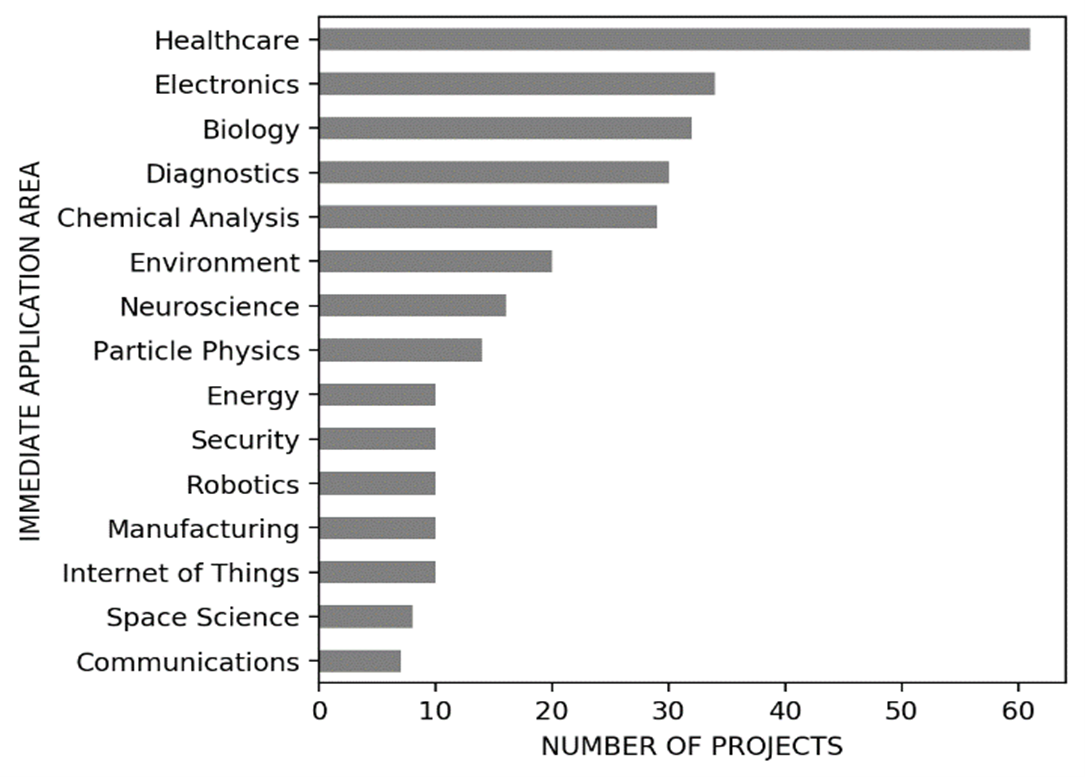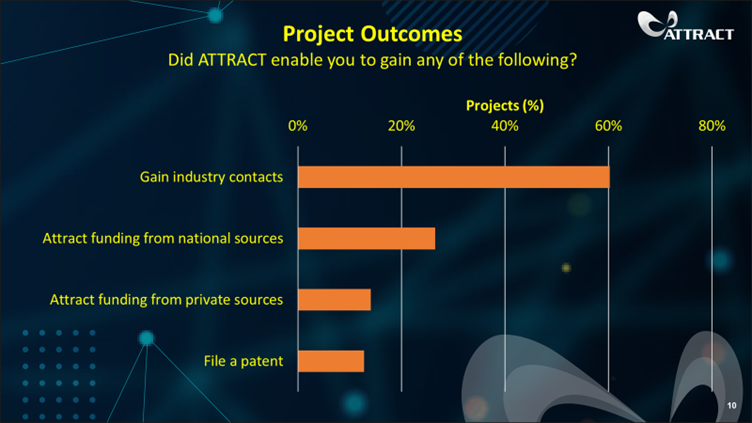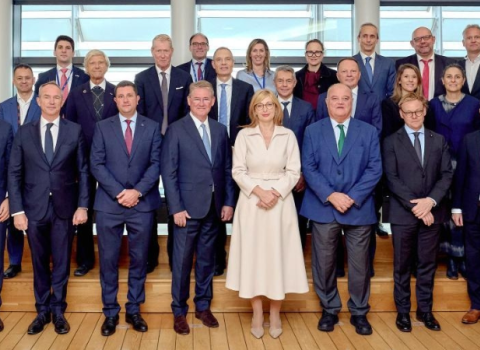An EU conference hears how the ATTRACT project tries to systematise the process of pushing disruptive ideas towards market success

ATTRACT workshop session at EU R&I Day.
In the development of any technology, there’s a mix of factors that determine success or failure: talent, money, skill – and a bit of luck. Now the question for European leaders, as they try to boost the EU’s technology base, is whether they can systematically increase the odds of all those things happening.
That policy issue was under discussion by a panel 24 September during the European Commission’s R&I Days online conference, and it is also the focus of a €17 million EU-funded project, ATTRACT. In the project, which funds 170 early-stage technology ideas from some of Europe’s greatest labs, the aim is to shake and stir all the right elements from money to serendipity to find successful applications and market niches for the technologies.
In essence, the ATTRACT project is a year-old experiment in government support helping make innovation happen, by creating a lively eco-system for public researchers and private partners to mix and work together, observed Jonathan Wareham, a professor at ESADE Business School in Barcelona and an ATTRACT co-founder.
The technologies involved – in imaging, detectors and related “deep tech” fields - are often “incredibly refined and sophisticated,” said Wareham. But the question ATTRACT asks is, “if these are developed for one scientific purpose, what mechanisms do we need to get them out of the (laboratory) infrastructure and into alternative applications where they can realise value for the European economy?”
Michael Krisch, chair of the ATTRACT consortium board and a scientist at the European Synchrotron Radiation Facility, said European scientists are at the forefront of new technology ideas, but they often “do not make it into the market” and are “not exploited for the benefit of society.” The idea of ATTRACT was to establish a framework for turning cutting-edge technologies into “breakthrough innovations with strong industrial applications,” said Krisch.
170 projects selected
ATTRACT is a consortium funded by the EU’s Horizon 2020 research programme and led by CERN, the big European high-energy physics lab (which, in the tech world, is known as the place the World Wide Web was first conceived, as a serendipitous outcome of its Nobel-winning scientific work.) The project partners include five other members of the European Intergovernmental Research Organisations Forum, plus ESADE, Aalto University in Finland, and the European Industrial Research Management Association. With EU funding, the group last year invited researchers across Europe to apply for €100,000 grants to help develop their promising ideas into business opportunities; 170 were chosen.
Of course, ATTRACT isn’t the only EU-funded effort to get early-stage European technologies heading faster to market. The much larger European Innovation Council (EIC) provides grants and other support to get ideas off the ground, and greater funding – including equity investment – to scale up the successful one. The European Institute of Innovation and Technology (EIT) convenes large, cross-EU public-private partnerships focused on topics like manufacturing, urban mobility, and energy. The European Research Council provides “proof of concept” funding to help its fundamental science grantees start developing applications for their discoveries.
The various EU programmes differ in their activities and structure, but have the “same mission,” which is the “translation of research findings in Europe to jobs and growth,” said Marja Makarow, director of Biocenter Finland. “These have been developed separately and independently: now the question is what are the synergies, how could these programmes really work together,” she said.

The study results
The ATTRACT idea, according to a new study by Wareham and ESADE colleagues, is that early-stage technologies could have valuable commercial uses that their creators never considered. That’s why proactive measures are needed to find such uses and get those technologies out of the lab and into the market.
The report argues that reliance on private capital and the free market alone may be insufficient to derive commercial innovation from the fundamental research being done in Europe’s publicly-funded research infrastructures. There is need for a “cultural change” where the public and private sectors come together, said Makarow, vice-president of the Finnish Research Council, speaking in the online panel discussion.
Though ATTRACT’s 170 projects cover a diverse array of technologies, the focus is on imaging and detection, because these are “really part of a lot of fundamental research projects,” and have uses in applied fields like medicine, said Cinzia da Via, a member of ATTRACT’s independent research, development and innovation committee. About 35 per cent of ATTRACT projects have applications in the healthcare sector, and 70 per cent involve sensor technologies in various application sectors. But ATTRACT also covers the various technologies that support detection and imaging, such as electronics, software and big data, said da Via, who is also a physics professor at the University of Manchester.

Real-world problems
Besides money and access to industry, ATTRACT also provides “a lot of training in business planning, commercialisation, entrepreneurship — even things like legal matters, sales and marketing,” said Wareham, who sits on the ATTRACT board.
In a survey of the ATTRACT participants, Wareham found that most of the 170 participants reported that they came up with their ideas after being presented with a particular problem, but before thinking of how the results could be used in alternative fields. The survey results show ATTRACT “gave them the opportunity to further work on those ideas,” said Wareham, “not only because of the financial seed money, but also because of the ecosystems, the training, the network, etc.” Participants found the connection to industry particularly useful, he said.
The survey found that the largest number (41 per cent) of ATTRACT participants found new applications for technologies by combining them with other technologies. For example, the SCENT project, which is creating a new type of gas sensor, merges the very different fields of gas-sensing and high-pressure technology. More than a quarter of projects (27 per cent) found new uses by taking a technology from one field and applying it in another: the SIMS project, for instance, is developing a seismic monitoring system using sensors that were designed to look for gravitational waves.
ATTRACT also enables students from various disciplines to work with the projects, which “familiarises a large group of up and coming members of society with what these technologies are, what they’re capable of, and what potential they have,” Wareham said.
Students were asked to help the projects find real-world uses for their technologies. “It’s really great for the students because it’s a real problem that we’re solving,” said Sini Simpura, an engineering student at Aalto University, who was also speaking on the 24 September panel. University work typically involves hypothetical or theoretical problems, but “now we get the chance to do something meaningful, so we have some other motivation than just the grades,” she said.
Simpura added that involving students from many different disciplines, not just engineering, helped move projects forward. “We did a lot of prototypes because we had a fashion student (in our team) and she said, ‘this is how we do it.’ And we thought for us that’s actually a really good way to do our project.”





 A unique international forum for public research organisations and companies to connect their external engagement with strategic interests around their R&D system.
A unique international forum for public research organisations and companies to connect their external engagement with strategic interests around their R&D system.